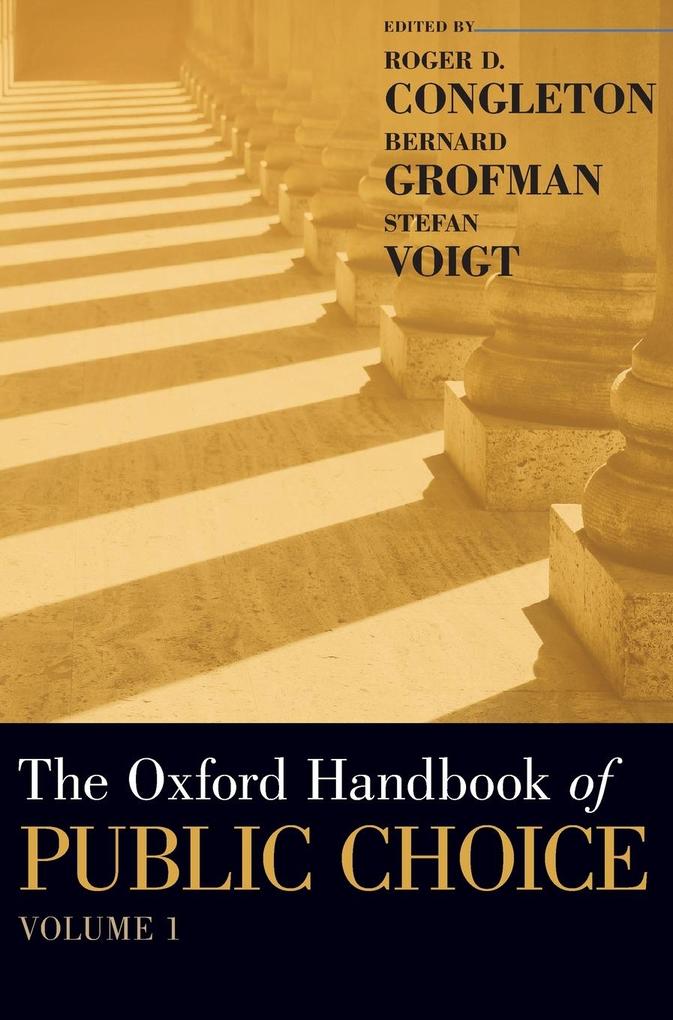
Zustellung: Do, 31.07. - Di, 05.08.
Versand in 2 Wochen
VersandkostenfreiThe Oxford Handbook of Public Choice provides a comprehensive overview of the research in economics, political science, law, and sociology that has generated considerable insight into the politics of democratic and authoritarian systems.
Inhaltsverzeichnis
- PART I: Introductory Essays
- 1. Rational Choice and Politics: An Introduction to the Research Program and Methodology of Public Choice
- Roger D. Congleton
- 2. Choosing among Governments
- Alan Hamlin
- 3. Public Choice: Early Contributions
- Dennis C. Mueller
- PART II: VOTING AND ELECTIONS
- A. Modelling Collective Choice in Voting
- 4. From Paired Comparisons and Cycles to Arrow's Theorem
- Donald G. Saari
- 5. Institution-induced Stability
- Kenneth A. Shepsle
- 6. Voting Power
- Stefan Napel
- 7. Aggregation of Information by Binary Voting Rules
- Shmuel Nitzan and Jacob Paroush
- B. Spatial Voting Models
- 8. Political Choices in One Dimension: Theory
- Bernard Grofman
- 9. Political Choices in One Dimension: Applications
- Bernard Grofman
- 10. Spatial Voting Models of Party Competition in Two Dimensions
- James F. Adams
- 11. Spatial Social Choice
- Norman Schofield
- C. Other Aspects of Voter and Party Choice
- 12. Economic Voting
- Michael S. Lewis-Beck and Mary Stegmaier
- 13. Valence Politics
- Haldun Evrenk
- 14. The Study of Strategic Voting
- André Blais and Arianna Degan
- 15. Turnout: Why do voters vote?
- Serguei Kaniovski
- 16. Expressive Voting
- Alan Hamlin and Colin Jennings
- 17. Altruism and Political Participation
- Richard Jankowski
- 18. Social Embeddedness and Rational Turnout
- Carole Jean Uhlaner
- 19. Information cues and rational ignorance
- Shaun Bowler and Stephen P. Nicholson
- 20. Manipulation
- Charles R. Plott
- D. Democracy in Practice
- 21. Campaign Finance
- Thomas Stratmann
- 22. Primaries, conventions, and other methods for nominating candidates: How do they matter?
- Gilles Serra
- 23. Logrolling and Coalitions
- Anthony J. McGann
- PART III: INTEREST GROUP POLITICS AND RENT SEEKING
- A. Interest Group Politics
- 24. Collective Action
- Jac C. Heckelman
- 25. Rent seeking: The social cost of contestable benefits
- Arye L. Hillman and Ngo Van Long
- 26. The Structure of Contests and the Extent of Dissipation
- Karl Wärneryd
- 27. The Political Economy of Rent Creation and Rent Extraction
- Roger D. Congleton
- 28. Empirical evidence on rent seeking costs
- Ignacio Del Rosal
- B. Political Agency Problems and Trust in Government
- 29. 'The Bureaucracy' as an Interest Group
- Patrick Dunleavy
- 30. Interest Groups and Regulatory Capture
- William F. Shughart II and Diana W. Thomas
- 31. Corruption
- Toke Aidt
- 32. The Political Economy of Trust
- Christian Bjørnskov
- C. Persuasion
- 33. Contested Political Persuasion
- Stergios Skaperdas and Samarth Vaidya
- 34. Stochastic Process Models of Preference Change
- Michel Regenwetter and Yung-Fong Hsu
- 35. Leadership as Persuasion
- Benjamin E. Hermalin
- PART IV: NORMATIVE POLITICAL THEORY: EVALUATING POLICIES AND POLITIES
- 36. Fairness Concepts
- Christian Klamler
- 37. Social Contract vs. Invisible Hand: Agreeing to Solve Social Dilemmas
- Viktor J. Vanberg
- 38. Utilitarianism as a Criterion for State Action
- Nicolaus Tideman and Florenz Plassmann
- 39. Public Choice and Happiness
- Bruno Frey and Alois Stutzer
- 40. Kantianism and Political Institutions
- Geoffrey Brennan and Hartmut Kliemt
- 41. Public choice and libertarianism
- Peter J. Boettke and Ennio E. Piano
- 42. Public choice and social democracy
- Peter Kurrild-Klitgaard
- 43. Supreme Values, Totalitarianism and Terrorism
- Peter Bernholz
- 44. Fair Division in Dispute Resolution
- Steven J. Brams
- 45. Fair Division in Allocating Cabinet Ministries
- Steven J. Brams
Mehr aus dieser Reihe
Produktdetails
Erscheinungsdatum
17. Januar 2019
Sprache
englisch
Seitenanzahl
984
Reihe
Oxford Handbooks
Herausgegeben von
Roger D Congleton, Bernard N Grofman, Stefan Voigt
Verlag/Hersteller
Produktart
gebunden
Gewicht
1741 g
Größe (L/B/H)
254/182/66 mm
ISBN
9780190469733
Entdecken Sie mehr
Pressestimmen
The articles are written for serious readers, and they give clear and concise statements of the material they cover. . . the essays in this Handbook will provide wonderful insights into the present state of public choice. Richard E. Wagner, George Mason University, Constitutional Political Economy
Bewertungen
0 Bewertungen
Es wurden noch keine Bewertungen abgegeben. Schreiben Sie die erste Bewertung zu "Oxford Handbook of Public Choice, Volume 1" und helfen Sie damit anderen bei der Kaufentscheidung.
































